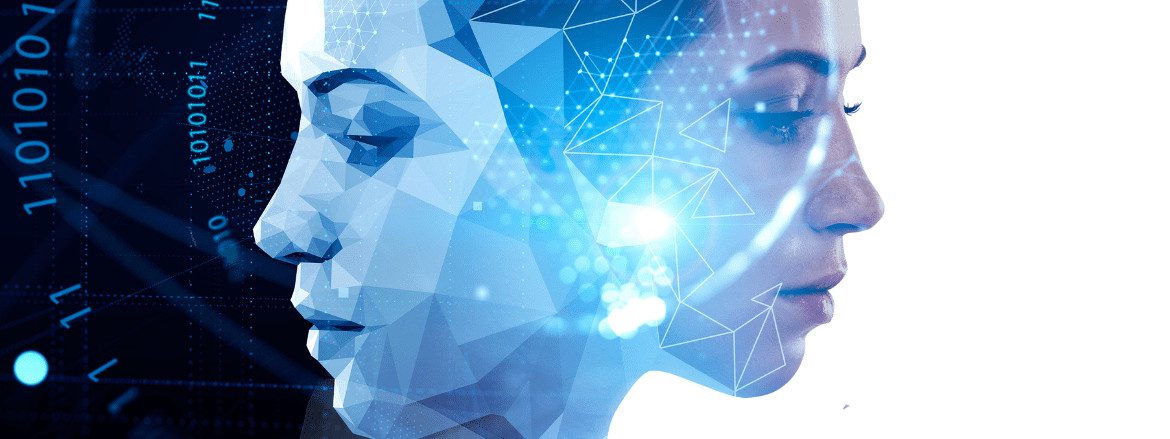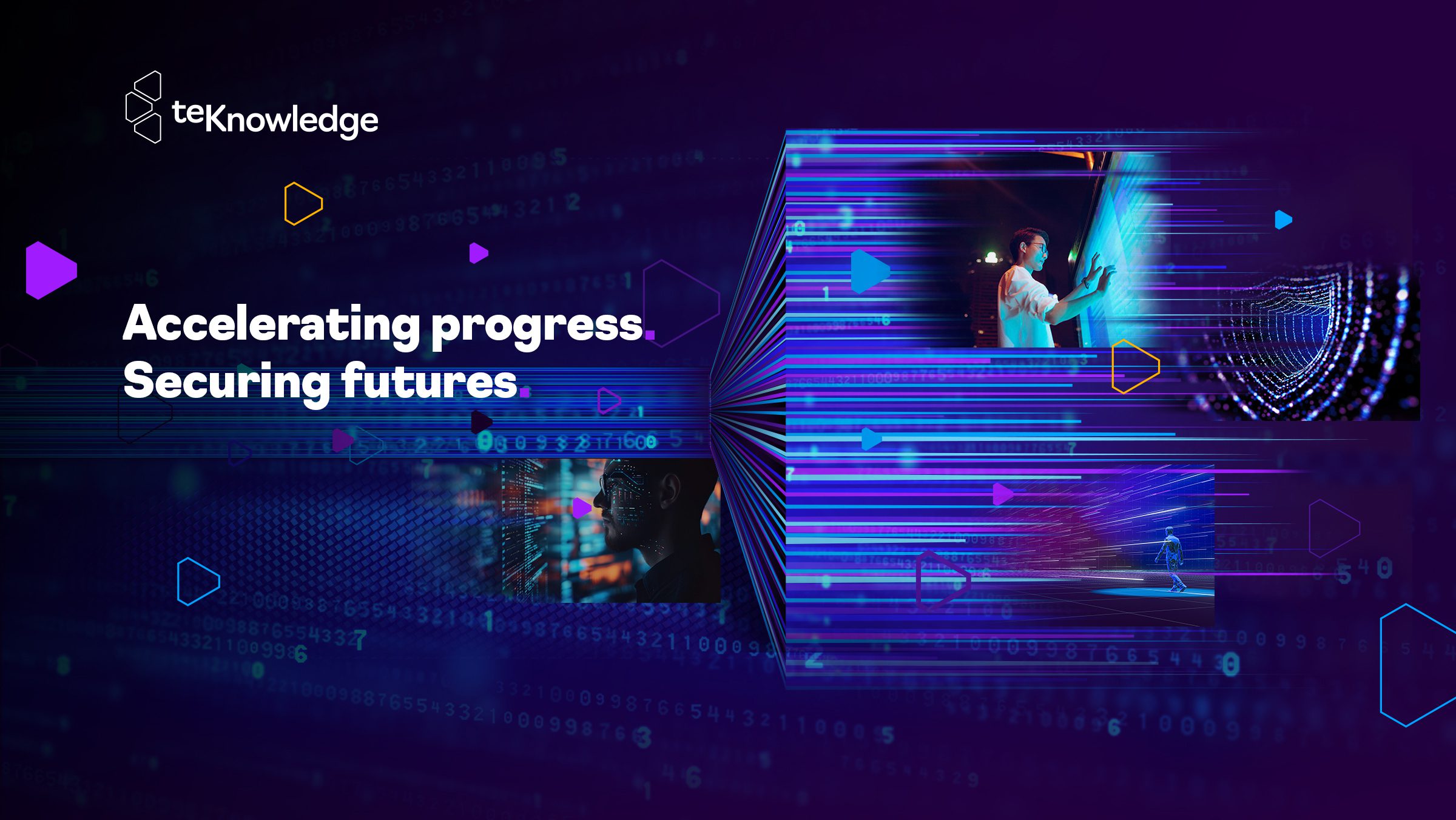Driving revenue and business growth remain top priorities for business leaders. Unfortunately, the cost to serve is rising and the time it takes to secure new accounts is lengthening. This makes existing accounts a critical source of revenue, but it can be difficult to scale your customer success teams to ensure long-term customer engagement and retention.
Many leaders are turning to AI and automation as a tool to improve efficiency and effectiveness, gaining the ability to streamline processes, increase scalability, and enhance productivity. But this raises the question: should technology support or replace human interactions?
“Certain elements [of customer success] can be empowered by technology but can never be replaced by technology.”
– Patricia Day, Head of Customer Success Workspace – Americas and Japan at Google
In a webinar hosted by TSIA, customer success leaders from Google and Tek Experts shared insights on automation and AI trends, the limitations of technology, the necessity of human touch, and how to implement a successful customer success strategy at scale.
Watch the webinar now or read our top 3 takeaways.
1. The current state of automation and AI
Technology is improving – but it’s not perfect. As tech leaders evolve their use of different technologies, they are finding that although it improves some business operations, there are still many areas that require a human touch, specifically when it comes to customer success.
Based on TSIA research, 85% of companies that offer auto-renewal capabilities report less than 20% of renewals are being completed through self-service. This low return on investment can most likely be explained by the fact that companies are making major investments in technology in short periods of time, making it difficult to implement effectively. Change management for both the business and customers is crucial for implementing new technologies, which requires time and resources that many businesses don’t have.
Additionally, the number of live, self-service chatbots in 2022 is less than half of the predicted spending since 2018. 43% of companies are developing their chatbots in-house with limited resources while also discovering that these chatbots don’t provide an engaging user experience. Customers are often forced to select from scripted options, and it can be difficult to connect with a live agent when needed, increasing customer frustrations.
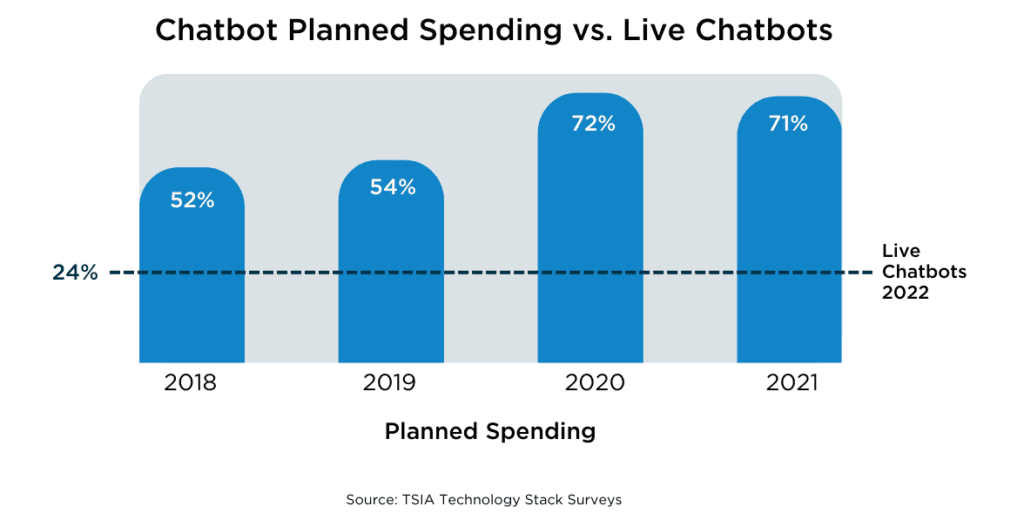
Meanwhile, Customer Success Managers (CSM) are in high demand and those that are highly qualified can have high salaries, competitive demands and the ability to jump to new employers with significant pay increases. Couple these high costs with only 34% average year-over-year growth for customer success budgets and it’s nearly impossible for businesses to assign internal CSMs to all customer tiers without breaking the bank.
For leaders to build a successful yet cost-effective customer success strategy, they’ll need to learn how to combine humans and AI to increase efficiency while maintaining strong customer relationships.
1. The art of balancing humans and AI
AI and automation are great at increasing efficiencies and productivity, but unlike Customer Success Managers (CSM), they lack a deep understanding of complex needs and the ability to build customer relationships. When implemented correctly and used for appropriate elements of the customer experience, technology can prove to be an extremely useful tool for CSMs to realign their focus on what matters most – the customer.
“[Tech] can’t replace the intimacy and the empathy that is part of a CSM’s DNA.”
– Patricia Day, Head of Customer Success Workspace – Americas and Japan at Google
The role of humans vs. technology in customer success
Humans are key for understanding customers’ complex needs, building meaningful relationships, and coordinating across teams to provide the best possible outcomes for customers. They build trust, act with empathy, think creatively, and actively listen, resulting in increased customer satisfaction and brand loyalty. Human touch is especially crucial during onboarding and adoption to ensure customers feel comfortable with your products and/or services and are realizing the full value of your offerings from day one.
Meanwhile, technology has difficulty understanding complex requirements and communicating with empathy since it often works off a general script and lacks the social awareness to build relationships. However, it can be leveraged for effective data analysis, predictive analytics, and automated efficiencies, enabling CSMs to focus more time on the customer and less on processes and organization.
Determining how and when to engage with customers
To determine how humans and AI fit into your customer success strategy, it’s crucial to define your customer segments. These customer segments should be revisited frequently as your customers’ businesses evolve, moving through their journeys and reaching key milestones.
“Customer segmentation is about getting the right resources aligned with the right customers at the right time.”
– David Mangham, Head of Global Customer Success, Tek Experts
Once you align segments with specific criteria, such as investment, customer journey stage, and account health, you can better determine how interactions should take place between customers and your business. Since human interaction requires more expensive resources compared to technology, the return on investment varies between customers.
Customers making larger financial investments or those at a high risk of churn tend to have more complex needs, meaning they require more complex solutions and engagement. This results in top-tier customers receiving most of the human interactions, while tiers of less invested customers receive more automated interactions. However, there should always be an aspect of human interaction across all tiers, especially to reduce churn risk among those lower tiers.
The challenge is affording human interaction across all customer segments.
2. How to scale customer success without increasing investment
Scaling your customer success function requires both humans and technology. If done right, your business won’t need to increase financial investments to succeed – you merely need to reallocate current resources to develop a more efficient customer success strategy.
“While the customer journey is the same, it’s how we deliver throughout the journey that’s different.”
– Bruce Hildyard, VP Strategy & Operations Customer Success
Improve efficiencies with technology
Look at instances in the customer journey that take a CSMs focus away from direct, meaningful interactions with the customer. Data analytics is a key area of focus for implementing AI because it can quickly process enormous amounts of customer data, analyze that data, and identify ongoing patterns, enabling CSMs to provide more proactive support.
AI and automation can also streamline recurring tasks like building and delivering monthly business reviews, data entry, ticket triaging, and answering basic, frequently asked questions that don’t require in-depth explanations. Many of these tasks can be particularly time-consuming for a CSM, but with the support of intuitive technology, they can focus more time and effort on building relationships with customers in each tier.
This transfer of responsibility from humans to AI can result in great cost savings and the conservation of crucial resources.
Increase human touch points with an experienced partner
CSMs are expensive and the competition continues to increase as employers seek talented professionals to serve their customers. But outsourcing customer success to an experienced provider can help optimize spend, increase human collaboration, and therefore increase customer satisfaction and retention.
Outsourcing customer success enables you to provide a human touch to 350 accounts for the same investment that would be needed to reach 50 accounts internally. Plus, a skilled partner can contribute to your knowledge base, providing best practices and greater insights based on experience.
In 2022, Tek Experts supported a client’s customer success team by implementing a human touch across underserved customer segments. They increased customer satisfaction (CSAT) by 10%, delivered a 10X return on investment, and drove $60 million in incremental revenue for the client.
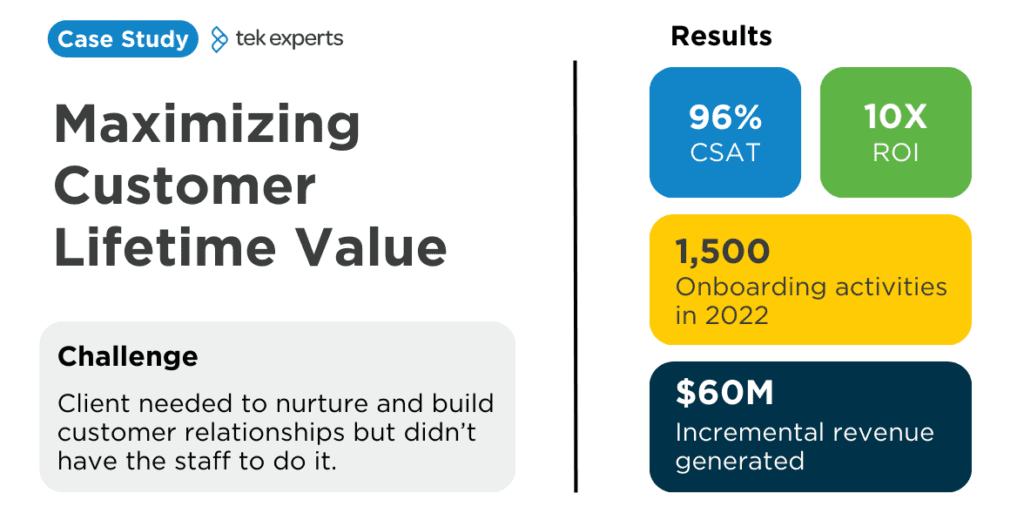
Outsourcing customer success can have serious effects on your businesses, but only if it’s right for you.
Determine what customer success model fits your strategy
When deciding if outsourced customer success will benefit your business, it’s important to identify the complexity of your solutions and if there are any segments of customers that are being underserved.
These will indicate whether a human touch is necessary for your customer experiences, and if any of your customers have a high churn risk or aren’t realizing the full value of your offerings, therefore costing you valuable up-sell, cross-sell, and renewal opportunities.
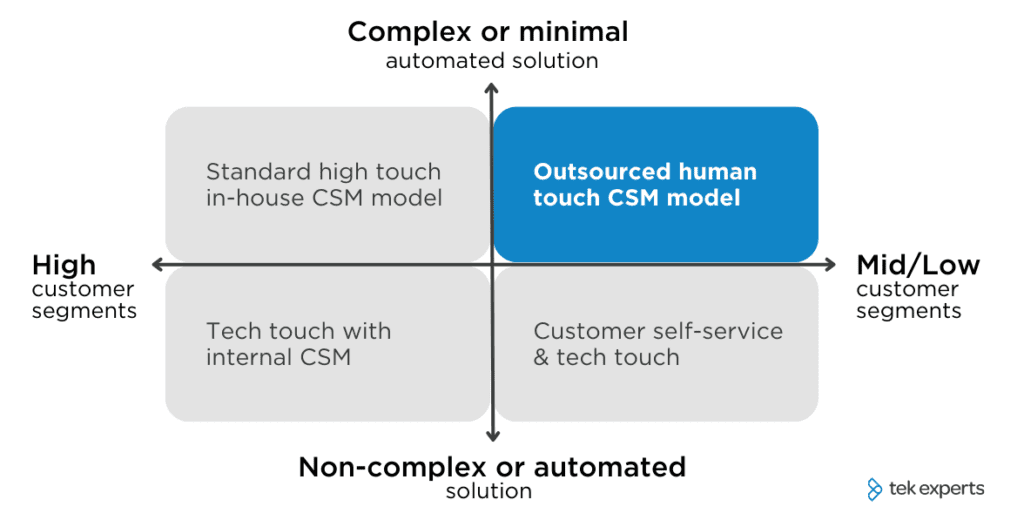
Build a Successful Customer Success Strategy
It’s no surprise, both humans and technology provide key benefits for driving revenue with customer success. The challenge is how to implement these cost-effectively in today’s market. Outsourcing customer success can be an extremely effective way to reduce costs and increase revenue, but it all starts with customer segmentation and understanding what experiences are most effective for your customers to be successful with your offerings.
Read more about how to develop and optimize your customer segmentation strategy.
